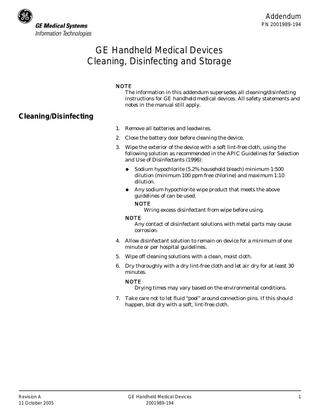GE Healthcare
MAC ECG Analysis Systems
GE Handheld Medical Devices Cleaning Disinfecting and Storage Addendum Rev A
Addendum
4 Pages

Preview
Page 1
Addendum PN 2001989-194
GE Handheld Medical Devices Cleaning, Disinfecting and Storage NOTE The information in this addendum supersedes all cleaning/disinfecting instructions for GE handheld medical devices. All safety statements and notes in the manual still apply.
Cleaning/Disinfecting 1. Remove all batteries and leadwires. 2. Close the battery door before cleaning the device. 3. Wipe the exterior of the device with a soft lint-free cloth, using the following solution as recommended in the APIC Guidelines for Selection and Use of Disinfectants (1996): Sodium hypochlorite (5.2% household bleach) minimum 1:500 dilution (minimum 100 ppm free chlorine) and maximum 1:10 dilution. Any sodium hypochlorite wipe product that meets the above guidelines of can be used. NOTE Wring excess disinfectant from wipe before using. NOTE Any contact of disinfectant solutions with metal parts may cause corrosion. 4. Allow disinfectant solution to remain on device for a minimum of one minute or per hospital guidelines. 5. Wipe off cleaning solutions with a clean, moist cloth. 6. Dry thoroughly with a dry lint-free cloth and let air dry for at least 30 minutes. NOTE Drying times may vary based on the environmental conditions. 7. Take care not to let fluid “pool” around connection pins. If this should happen, blot dry with a soft, lint-free cloth.
Revision A 11 October 2005
GE Handheld Medical Devices 2001989-194
1
Cautions Never immerse the device in any liquid. Do not pour or spray any liquid directly on the device or permit fluid to seep into connections or openings. Never use conductive solutions, solutions that contain chlorides, wax, or wax compounds to clean the device. Never use solutions or products that contain the following: Any type of Ammonium Chloride such as, but not limited to: Dimethyl Benzyl Ammonium Chloride Quaternary Ammonium Chloride solutions Abrasive cleaners or solvents of any kind Acetone Ketone Betadine Alcohol-based cleaning agents Sodium salts Never autoclave or steam clean the device. Do not attach the device to a patient until it is thoroughly dry.
Storage Always remove batteries when the device is not in use (even for short periods of time). Store in a dry well-ventilated area. Hang the device, use a holder if available. If leadwires/cables are attached, they should hang straight. Do not coil leadwires/cables tightly around the device.
Improper Cleaning Products and Processes Impact/Results Appearance of waveforms when the device is not connected to a patient, causing false alarms instead of a leads fail alarm and may not provide a visual and/or audible leads fail alarm. Brittle and breaking device case. Overall system performance degradation. Melting, dulling, or distorting the case. Total handheld medical device failure requiring replacement. Unit malfunction. Void warranty.
2
GE Handheld Medical Devices 2001989-194
Revision A
Cleaning Products To Avoid Cleaning products known to cause the types of problems listed above include, but are not limited to: Sani-Cloth® Wipes Ascepti® Wipes HB Quat® Clorox® Wipes (they do not contain bleach) Over-the-counter detergents (e.g. Fantastic®, Tilex®, etc.). Products that contain active ingredients and solutions similar to these products should also be avoided. NOTE For additional information, refer to the How to Reach Us page of the manual for contact information. Also see the GE ECG Cables and Leadwires Cleaning, Disinfecting and Storage addendum.
Battery Compartment Cleaning (Frequency Hopping Telemetry Transceivers ONLY) CAUTIONS The battery compartment is not waterproof. Make certain fluids do not enter the electronics through the air holes in the batter compartment floor. Cleaning the battery compartment in a manner other than that specified below may cause the unit to malfunction and void the warranty Under normal operation, the battery compartment should not require cleaning. If the battery compartment does require cleaning, then use the following instructions. 1. Remove the battery from the battery compartment. 2. Clean the device with a gauze pad or cloth lightly moistened with one of the following agents: Water Soap 3. Use a cloth lightly moistened with distilled water to rinse away the cleaning solution. Make certain that moisture does not enter the electronics area below the battery compartment floor. 4. Dry thoroughly with a lint-free cloth. Allow the battery compartment to air dry completely prior to closing the compartment door.
Revision History
Revision A
Revision A
Comments Initial Release.
GE Handheld Medical Devices 2001989-194
3
GE Medical Systems Information Technologies 8200 W. Tower Ave., Milwaukee, WI 53223 U.S.A. © 2005 General Electric Company. All rights reserved. For your notes
4
GE Handheld Medical Devices 2001989-194
Revision A